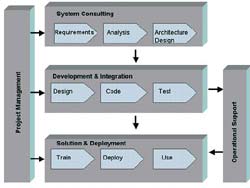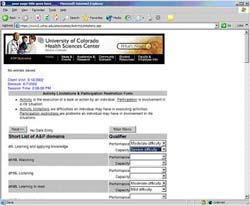Development of an Assistive Technology Outcomes Measurement System Utilizing the International Classification of Functioning (ICIDH-2/ICF)
ABSTRACT
The purpose of this development project is to further the design and implementation of a secure, HIPAA (Health Insurance Privacy and Accountability Act of 1996) compliant, multi-site, web-based assistive technology (AT) outcomes system designed to capture data that will enable the measurement of the impact of assistive technology devices and services for children and adults with disabilities. This presentation will focus on an update of progress, audience feedback and future directions.
KEYWORDS
Assistive technology outcomes, HIPAA, and measurement
BACKGROUND
Some important evolutions have been occurring during the past decade or so that have both encouraged and strengthened efforts surrounding measurement of the impact of assistive technology devices and services. The evolution began with the passage of a number of important laws and initiatives: the Technology Related Assistance Act for Persons with Disabilities of 1988 [1] and its amendments [2], followed in 1992 by amendments to the Rehabilitation Act of 1973 [3], the Individuals with Disabilities Act (amended 1997) [4], the Americans with Disabilities Act (1992) [5] and most recently The President's New Freedom Initiative (2001) [5]. These legislative activities along with some welcome changes in the insurance industry have suggested, and in some cases mandated, that assistive technology devices and services are important for persons with disabilities and need to be provided.
Another evolution has been the development of faster, more powerful computers and software applications. Today's technology enables us to do things better, cheaper and faster than ever before. The field of assistive technology has also exploded. Tens of thousands of devices are available for use by persons of all ages, disabilities and abilities. Each year, more and more practitioners, end-users and family members recognize the potential benefits of AT devices and services. What hasn't been available however is a systematic methodology for collecting information about the effectiveness of specific AT devices and services across large groups of end-users over time. Recognizing this need, the National Institute of Disability Research and Rehabilitation (NIDRR) has led national efforts to ameliorate this deficiency by funding projects that are focused on AT outcomes measurement. The two key elements in the organization and design of this project is the use of the International Classification of Functioning, Disability and Health (ICIDH-2/ICF) as the framework for development and builds on initial pilot work already completed by faculty of Assistive Technology Partners, University of Colorado Health Sciences Center, and collaboration with two NIDRR funded national projects focused on AT outcomes development (ATOMS/CATOR).
RESEARCH QUESTION
The primary research question for this project centers on the need to maximize the full inclusion of individuals with disabilities into society, employment, independent living, family support, and economic and social self-sufficiency, especially individuals with the most severe disabilities; and the need for improved information and research on the effectiveness of assistive technology devices and evidence-based practices.
METHOD
 |
Our long-range goal is to develop a secure, hand-held and accessible desktop system that clinicians and researchers can easily use on-site or at their workplace while engaged in AT assessments and AT service delivery activities. The clinician will enter standard information (name, demographics, etc.) using either a stylus or keypad as well as specific data related to the AT device being considered or used; the individual's performance with and without assistive technology; as well as other defined variables. When finished entering data, the clinician will sync the hand-held device with a standard interface and send the data to the secure network server. Should the clinician wish to see how well the interventions are working over time, he or she will be able to query the system using secure access strategies to view individual client data. Each variable will have a built-in graph display (ChartFX) to provide an instant visual as to how well the individual is performing with their current AT setup.
For qualitative and contextual information, clinicians will be able to review text information. A report-writing format will be embedded within the program to enable clinicians to print individual clinical reports for medical records and insurance requirements.
 |
Once data reaches the secure server all identifying information will be separated from individual client records to enable large-scale queries (please see development plan below). Participating AT researchers will have the flexibility to design their own query strategies to quantify data or retrieve qualitative data that has been coded.
We have designed the development activities to coincide with both end-user and engineering team efforts in order to effectively accomplish our objective of developing a secure, multi-site, web-based outcomes measurement system that can be accessed at varying levels by clinicians and researchers. Clinicians will have the ability to enter data and review end-user progress to guide service delivery; researchers (with approved research protocols) will have the ability to develop queries for research questions and various models for analysis.
RESULTS
This presentation will focus on demonstrating the results of this development project to date along with providing opportunities for audience feedback and participation in the design process.
REFERENCES
- PL 100-407. (1986). Technology-Related Assistance for Individuals with Disabilities Act, 1988.
- P.L. 103-218. (1984). Amendments to the Technology-Related Assistance for Individuals with Disabilities Act of 1988.
- P.L. 99-506. (1986) Amendments to the Rehabilitation Act of 1973
- P.L. 101-476. (1991). Individuals with Disabilities Education Act.
- P.L. 101-336. (1990). Americans with Disabilities Act.
- U.S. Whitehouse. New Freedom Initiative for Americans with Disabilities, from http://whitehouse.gov/news/freedominitiative.html
- World Health Organization (2000). International classification of functioning, disability and health: Prefinal draft, full version, World Health Organization. 2000.
- International Clasification of Impairments, Disabilities International, and Handicaps. A Manual of classification relating to the consequences of disease. World health Organization. Geneva, 1980.
- Brandt, E.N., Pope, A.M. (eds.). Enabling America: Assessing the role of rehabilitation science and engineering. National Academy Press. Washington, D.C., 1997.
- DeRuyter, F. (1995). “Evaluating outcomes in assistive technology: Do we understand the commitment?” Assistive Technology 7 (1): 3-8.
- DeRuyter, F. (1997). “The importance of outcome measures for assistive technology service delivery systems.” Technology and Disability 6 (1,2): 89-104.
- Gray, D. B., Quatrano, Louis A., Lieberman, Morton L. (1998). Designing and using assistive technology: The human perspective. Baltimore, Paul H. Brooks.
- Trachtman, L. (1996). “Measuring and documenting assistive technology outcome.” Assistive Technology 8 (2): 67-70.
- Cushman, L. A. S., Marcia (1996). “Measuring the relationship of assistive technology use, functional status over time, and consumer-therapist perceptions of AT.” Assistive Technology 8 (2): 103-109.
- Jutai, J., Ladak, Nizer; Schuller, Reinhard; Naumann, Stephen; Wright, Virginia (1996). “Outcomes Measurement of assistive technologies: an institutional case study.” Assistive Technology 8 (2): 110-120.
- Merbitz, C. (1996). “Frequency measures of behavior for assistive technology and rehabilitation.” Assistive Technology 8 (2): 121-130.
- Oldridge, N. (1996). “Outcomes measurement: Health related quality of life.” Assistive Technology 8 (2): 82-93.
ACKNOWLEDGMENTS
This study was funded by the National Institute on Disability and Rehabilitation Research grant # H133G030187.
Author Contact Information:
Cathy Bodine PhD, CCC-SLP
1245 East Colfax Avenue, Suite 200,
Denver, Colorado 80218
Office Phone (303) 315-1281
EMAIL: cathy.bodine@uchsc.edu
Meegan Van Straaten MSPH, PT,
1245 East Colfax Avenue, Suite
200,
Denver, Colorado 80218
Office Phone (303) 315-1281
EMAIL: meegan.vanstraaten@uchsc.edu
